
|
|

May 22, 2009
Neuticonacanut Hill and WSBE, Providence, R.I.
So here we are - again - at the finish line for analog full-power TV in the United States.
Unless it changes once more (and this time it looks pretty firm), June 12, 2009 will mark the end of more than seven decades of analog television, which means there are a whole bunch of transmitters, and a few transmitter sites, that we wanted to document here on Site of the Week before they're gone.
That's about the only excuse we can come up with for heading from upstate New York through Utica and Albany to Providence and Boston in early February, a season when we're usually either holed up at home or heading for warmer climates down south or out west.
But when a deadline is bearing down, no winter storm off the north Atlantic, like the one that greeted us on our first morning in the Providence market, is enough to keep a good tower-hunter down. (And we had the easy part, having spent the previous night in a motel in nearby Seekonk, Massachusetts; our tower-hunting compatriot Garrett Wollman had to drive down from his home near Boston in the slush and snow.)
In this week's installment, we continue our snowy circuit around Providence with a visit to the market's oldest surviving FM sites, up on Neuticonacanut Hill in Johnston, just southwest of the Providence city line.
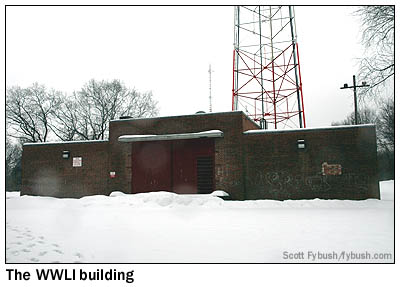
|
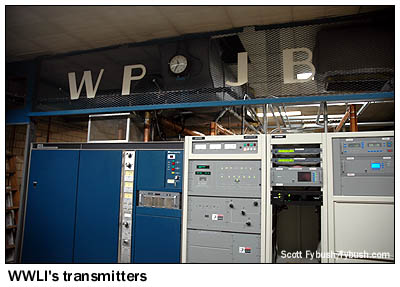
|
Neuticonacanut Hill (sometimes spelled "Neutaconkanut," and pronounced "newt-ih-CON-ca-nut"), all of 270 feet above sea level, saw the arrival of two FM stations within months of each other in 1948, and both sites survive, largely unaltered, today.
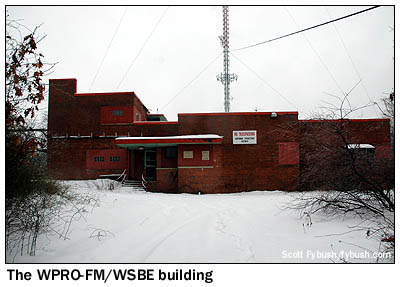 In
July 1948, the Providence Journal and Providence Evening
Bulletin put WPJB (105.1) on the air as a standalone station
with studios on a newly-added top floor of the Journal-Bulletin
building and transmitter in a low-slung brick building on
the hill, complete with a self-supporting tower out back and
a big glass window in front allowing visitors to see the transmitter
- and the nifty metal Art Deco "W P J B" lettering
and big clock above the transmitter.
In
July 1948, the Providence Journal and Providence Evening
Bulletin put WPJB (105.1) on the air as a standalone station
with studios on a newly-added top floor of the Journal-Bulletin
building and transmitter in a low-slung brick building on
the hill, complete with a self-supporting tower out back and
a big glass window in front allowing visitors to see the transmitter
- and the nifty metal Art Deco "W P J B" lettering
and big clock above the transmitter.
The windows have long since been covered over (though the metal panels can be removed to allow easy access into the building), but the lettering and the clock remain, now overlooking two newer Harris and BE transmitters for what's now Citadel's "Lite Rock 105.1," WWLI.
A few blocks away, the very first Providence FM site is still going, too - still home, in fact, to the very same station with the very same callsign it used on day one in April 1948.
WPRO-FM (92.3) is now a sister station to WWLI under Citadel ownership, and its top-40 format would probably be unrecognizable to an engineer from those early days six decades ago.
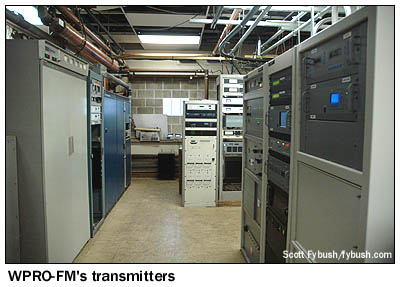
|
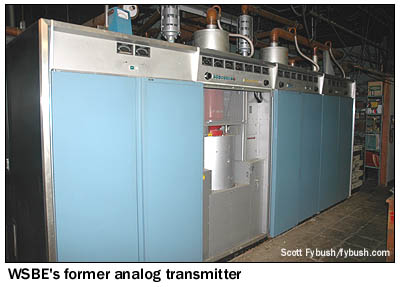
|
Those early engineers would probably be amazed, too, at the modern Harris digital transmitter that greets visitors to the transmitter room, where it sits alongside older Harris backup transmitters.
So why the huge building? Some of it was for the staff needed back in the days when the FM transmitter needed to be tended around the clock - but some of it was for WPRO-TV (Channel 12, now WPRI), which started up here in Johnston in 1955 before moving in 1974 to its current site in Rehoboth, Mass. In its very earliest days, WPRO-TV had both its transmitter and a rudimentary studio and master control here on the hill, though the studio soon moved downtown to a new building for radio and TV at 24 Mason Street.
For its last few years here, WPRO-TV shared the site with a hulking RCA transmitter for Rhode Island's public TV station, WSBE-TV (Channel 36). The relationship between WPRO and WSBE was a close one over the years; in addition to providing transmitter space on the hill (indeed, we first heard of "Neuticonacanut Hill" from watching WSBE's nightly 11 PM sign-off announcement in the early nineties), WPRO donated its Mason Street studios to WSBE when the commercial radio and TV stations moved to new studios in the mid-seventies.
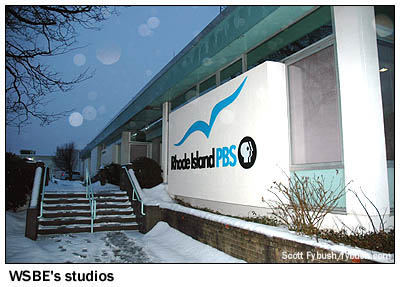
|
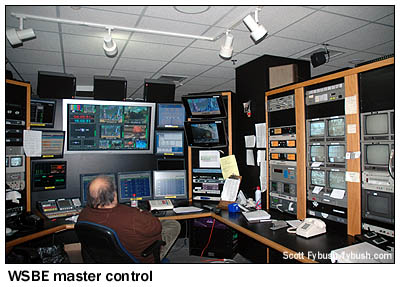
|
By the time of our visit in early February, that big RCA transmitter on Neuticonacanut Hill - supposedly the very last one off RCA's production line in Camden, N.J. - was silent for good, having suffered "catastrophic failure" (the demise of its water-cooling pump) a few weeks earlier that ended WSBE's analog broadcasts ahead of schedule.
But the end of that analog signal was far from the end for WSBE; in fact, in some ways, it marked a new beginning for the station recently rebranded "Rhode Island PBS."
If nothing else, it at least gave us a good excuse to head over to the current Rhode Island PBS studios on Park Lane, in an industrial park off Route 10 on the Providence/Cranston line, for a quick tour.
The RI PBS master control is visible through a big glass window right off the lobby, and inside we find a newly-rebuilt digital facility controlling two signals - 36.1 in HD and "WSBE Learn" on 36.2.
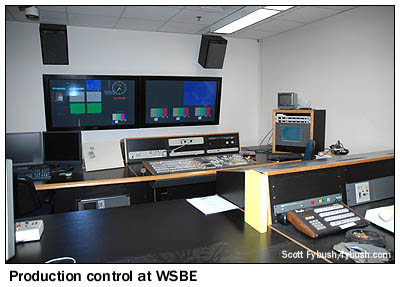
|
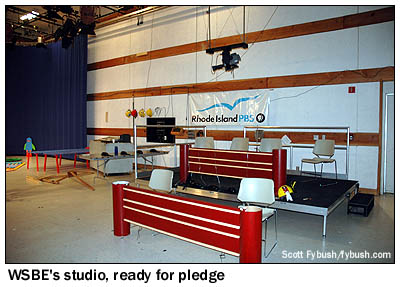
|
WSBE's master control shares a big tech center facility with an ingest area, the station's broadcast automation and racks full of STL gear, the station's computer systems, and more. Moving toward the back of the building, we get a peek at the production control room, adjacent to the two very large studios, one of them set up from a recent pledge drive. It's not a fancy facility, but it certainly gets the job done - and RI PBS has established itself as a quirky alternative to the big-market PBS signals in adjoining markets, especially Boston's WGBH, with which it has a huge overlapping footprint south of Boston.
Speaking of Boston, that's where we'll head for next week's installment of our winter trip - and in the meantime, even though we didn't get good pictures of the towers on Neuticonacanut Hill here, you can see some much better ones over at NECRAT.com . And you can learn more about the histories of these stations over at BostonRadio.org, where Garrett Wollman has a draft up of a comprehensive history of Rhode Island broadcasting, from which some of the information presented here (especially the timeline of early Providence FM) was derived.
- Previous Site of the Week: Providence, RI (Part I)
- Next Week: WHDH/WLVI and WCVB, Boston
- Site of the Week INDEX!
- How can you help support Site of the Week? Click here!
- Submit your suggestions for a future Site of the Week!
